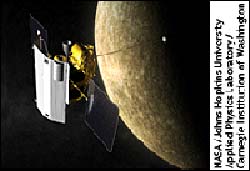Going to Mercury? Don’t leave home without a NIST calibration

Artist’s impression of the MESSENGER spacecraft in orbit around Mercury.
The first spacecraft intended to orbit Mercury was launched on Aug. 3, 2004, carrying an instrument for mapping the composition of the planet’s crust that was calibrated with a novel procedure at the National Institute of Standards and Technology (NIST). The procedure, using NIST-produced, high-energy gamma rays, enabled the device to be prepared for the same intense radiation levels typically produced in outer space.
Mercury is a rocky planet like the Earth but smaller, denser and with an older surface. Scientists believe that by studying Mercury they can develop a better understanding of how the Earth formed, evolved and interacts with the Sun.
Scheduled to orbit Mercury in 2011, the National Aeronautics and Space Administration’s (NASA) MESSENGER (MErcury Surface, Space ENvironment, GEochemistry, and Ranging) spacecraft carries seven scientific instruments, including a detector that will measure gamma rays emitted by Mercury’s crust as it is bombarded by cosmic rays. The bombardment releases neutrons, which react with the elements in the crust; analysis of the resulting gamma rays will help identify the elements. The detector’s efficiency (the fraction of incoming gamma rays detected) needed to be calibrated based on the gamma-ray energy for 37 different orientation angles associated with the orbits around the planet. Typical gamma ray sources, such as those used for medical treatments, emit at lower energy levels than those needed for the calibration.
NIST scientists, in collaboration with the mission’s prime contractor, the Johns Hopkins University Applied Physics Laboratory, solved the calibration problem by using a high-intensity neutron beam to irradiate targets made of sodium chloride and chromium. The targets captured neutrons and emitted gamma rays, which were measured by MESSENGER’s gamma-ray detector. These gamma rays spanned the energy range that will be measured in the planetary assay. According to Johns Hopkins’ Edgar A. Rhodes — lead scientist for the MESSENGER instrument –the calibration procedure “will likely set a new standard for space-flight gamma-ray spectrometers.”
Media Contact
More Information:
http://www.nist.govAll latest news from the category: Physics and Astronomy
This area deals with the fundamental laws and building blocks of nature and how they interact, the properties and the behavior of matter, and research into space and time and their structures.
innovations-report provides in-depth reports and articles on subjects such as astrophysics, laser technologies, nuclear, quantum, particle and solid-state physics, nanotechnologies, planetary research and findings (Mars, Venus) and developments related to the Hubble Telescope.
Newest articles

A universal framework for spatial biology
SpatialData is a freely accessible tool to unify and integrate data from different omics technologies accounting for spatial information, which can provide holistic insights into health and disease. Biological processes…

How complex biological processes arise
A $20 million grant from the U.S. National Science Foundation (NSF) will support the establishment and operation of the National Synthesis Center for Emergence in the Molecular and Cellular Sciences (NCEMS) at…

Airborne single-photon lidar system achieves high-resolution 3D imaging
Compact, low-power system opens doors for photon-efficient drone and satellite-based environmental monitoring and mapping. Researchers have developed a compact and lightweight single-photon airborne lidar system that can acquire high-resolution 3D…





















